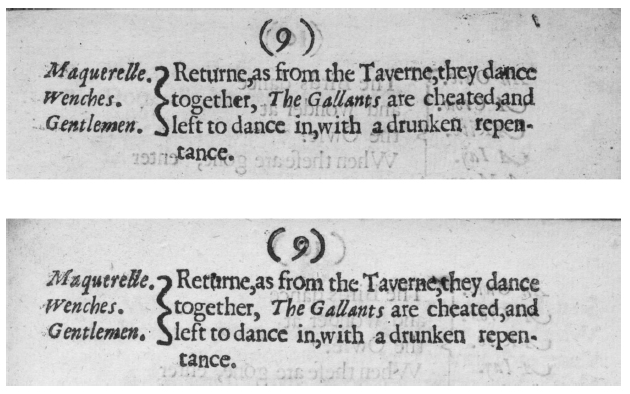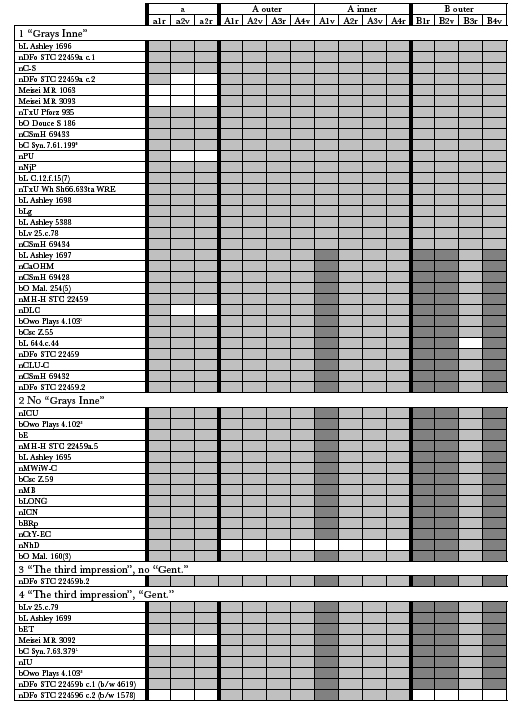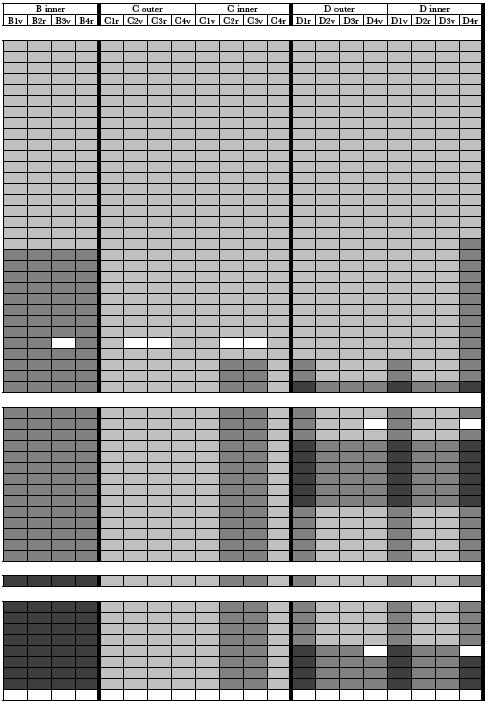| JAMES SHIRLEY'S TRIUMPH OF PEACE:
ANALYZING GREG'S NIGHTMARE
by
STEPHEN TABOR
| ||
§2. Headlines
ToP contains no running titles. Except for the words "The
Epistle" on a2v,
the headlines consist of simple page numbers within
parentheses—three or four
types plus spacers. Figure 2 shows two states of a page
(C1r) in which the headline
has been reset. This is not just a spacing shift—all
three printing characters are
different types. But the setting below is unchanged,
and even the direction lines
are unaltered (both contain the catchword "An_" with a dropped hyphen). On
some other pages, both the
numbers and the direction lines show resetting—
for example B3r in Houghton STC
22459 as compared with the same page in
Houghton STC 22459a.5. Still others have
page-number resettings in conjunc-
tion with stop-press corrections. On A1v,
Bodleian Mal. 160(3) has three errors
that are corrected in National Art Library
25.c.79.
15
The priority seems
clear.
However, along with the corrections comes a reset page number: originally
well
printed, the "2" in the apparently later state is badly damaged and the left
pa-
renthesis prints much thinner than the right. The nature of the damage to
the
numeral makes it unlikely that we are looking at the same unhappy type,
and
the parentheses are also clear substitutions. In the act of improving the
text, the
printer seems for no discernible reason to have swapped out a good page
number and substituted a bad one.
Finally, a new headline always appears in those cases (mentioned in the
pre-
vious section and discussed more fully in the next) where selected blocks of
text
are reset seemingly without need. Headlines are reset even when they are
not
adjacent to the reset text. Huntington copies 69434 and 69428, for
instance,
show this phenomenon on C2v.
Most of these headline replacements also entail a reset direction line,
though
the latter can be difficult to detect. Of the two features, I have found
the page
numbers to be a clearer first indicator that something unusual is going
on, for


way twice; their horizontal alignment with the first line of text is variable; and
the numbers and parentheses in Norton's type-cases contain a variety of forms
and damaged sorts that make substitution easy to detect.
The page-number changes in ToP are so clearly without purpose
that they
must have been unintended consequences of other operations. We can
explore
their patterns by modifying table 1 to show where the substitutions occur.
In table
3, the double horizontal lines indicate page-number changes.
16
These obviously
occur also at the
points where whole pages are reset (still shown by changing
shades of gray), but
others divide the main settings into smaller groups. A reset
number on one page
usually accompanies a similar operation on its forme-mates,
and the table shows
corresponding fault-lines that often break out of individual
formes into whole
quires and even to the other sheets. The initial impression of
chaos in table 1
begins to yield to a pattern that is more complex, but also more orderly.
The page numbers in ToP belong to an element common to most
books
of the hand-press period called the skeleton forme. This consisted of
non-printing
material such as the furniture that held the pages in a set layout on
the press
bed, but it also included the headlines and direction lines. The latter
contained



So, the skeletons tended to get re-used, with changes to the visible type as needed,
in successive formes as an edition went through the press. When a forme was
finished printing, the units of the skeleton were normally separated from the type-
pages and used in another forme, while the stripped pages went back to the type
cases for distribution. 17 After the edition was finished, the type of the skeletons
would go down the same path.
It was entirely possible to do multiple printings of a short book using the
same
setting of type. In such a scenario, the type-pages, after their first
printing, would
be tied up with string, with or without their skeletons, for an
arbitrary period,
then reimposed and reprinted. This cycle could repeat itself as
many times as
needed. Printers commonly stripped the headlines and direction lines
when pages
were finished printing, but if the skeletons happened to remain with
their pages, a
reprint could easily escape detection even by a modern
bibliographer. Numerous
examples of reprinting from standing type, at least for
stretches of a few pages,
are documented from the early seventeenth century and
before,
18
and the prac-
tice
became rather common by the late eighteenth century. The reasons it was
not more
widespread in the 1630s were both practical and regulatory.
Between
1587 and 1637, an order of the Stationers'
Company set a limit of 1500 copies
on print runs from a single
setting.
19
If more copies were
wanted, a scrupulous
printer would have distributed the type and reset a new
edition from scratch.
This rule was intended to provide sufficient work for
journeyman compositors,
but it also made economic sense. Because hand-cast type
was expensive, a printer
would keep only limited amounts and would not want large
chunks of it tied up
and unusable for other jobs. Nevertheless, printers
interpreted the regulation
flexibly, and when faced with a sudden high demand for
a particular title they
were understandably tempted to exceed the limit.
20
If we encounter a book whose copies show only minor changes to the text
but two
entirely different settings of the running titles, we have a strong case
that the
edition went through two impressions. In the interval between them,
the skeletons
got distributed and had to be reset for the second run. This is
what I believe
happened repeatedly with The Triumph of Peace. I would contend

an interruption of work during which the whole forme was removed from the
press. The type-pages were set aside for a time and then received at least reset
page numbers, and usually new direction lines as well, in preparation for re-
impression. Some pages underwent a complete resetting during the interval, of
course including the skeleton. This is the explanation of the horizontal fractures
in table 3. It is even possible that some pages were stored with their skeletons
intact and went undetectably into later impressions. This could have occurred
with formes D(o) and A(i) at certain points in the printing history; it is tempting
to posit "silent" reimpositions that would bridge the discontinuous fault-lines in
table 3. We will explore this possibility when we go into the life-histories of the
individual quires.
I have ignored some anomalies in forme B(i) that will be
discussed in §6C. In late copies
of quire D, two settings occur
interchangeably; therefore it is not possible to diagram a clear
transition
from one to the other.
Curiously, Joseph Moxon does not
discuss this practice (Mechanick Exercises on the Whole
Art
of Printing, ed. Herbert Davis and Harry Carter. 2nd ed. London:
Oxford University Press,
1962); but the books themselves give
frequent evidence of it.
A search in ESTC for note-word "reimposed" will turn up some of
these (e.g., S92876
(1583) and S125309 (1572?). See
also Greg, English Printed Drama, entries 28(b)
(1559), 75(b)
(l578), 202(b) (l604), 203(b)
(1604), 204(b,c) (1604–05), 217(b) (l605), 230(b)
(l606), 295(b)
(1611), 296(d) (1635), 412(b)
(1625), and L18(AII) (1641?). Another probable example
is Greg
466, explored by J. Caitlin Finlayson> in
"Thomas Heywood's
Londini Artium & Scientiarum Sca-
turigo
(1632): The Huntington and Worcester Copies—Two Issues or Variant
States?" (Papers
of the Bibliographical Society of America
, 108.3 [Sept. 2014], 325–341).
| JAMES SHIRLEY'S TRIUMPH OF PEACE:
ANALYZING GREG'S NIGHTMARE
by
STEPHEN TABOR
| ||

